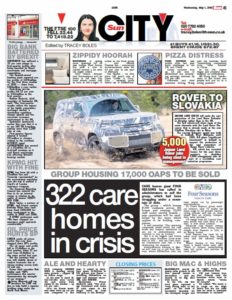
This month’s 4media group breakfast seminar looked at the business and city pages of the British press. A page that has taken a Brexit beating recently, with everything being affected. It’s often a page that many people wrongly assume only relates to a specific subset of audiences, but in reality, it’s something that affects us all. It could be covering the stock market and banking issues, which may affect our lives financially. Or it could be discussing a new way of working, a business scandal, a new innovation in a certain product or car, the impact of work and city life on our health. Why wouldn’t you want to know about that?
To discuss these specific pages of the press, we invited Award Winning journalist, and Business Editor of The Sun, Tracey Boles and the Times’ Industry Editor, Robert Lea, to talk about what they look for in a business and city story that will help PRs earn coverage on their pages. They were accompanied on our panel by our in-house Head of News, Alan Edwards, who has over 20 years of experience in journalism, having worked most recently as Night Editor at The Sun.
Every month a lot of the same points crop up. For example having an attention grabbing subject line, getting to know the journalists you’re trying to attract, and knowing what time to pitch to them are tips that everyone of the experts we’ve had in has reiterated. With that in mind, and to give you something new, we’re giving you tips on what PRS can give journalists, from the expert’s very own lips:
-
CONTENT

Many people may think journalists are overflowing with stories to print, and don’t get us wrong, some days journalists can’t move for stories. But the phrase ‘slow news day’ didn’t come from nowhere. Some days are bare; Column inches are hard to come by and pages are hard to fill. That’s where us PR’s come in. We’re ‘the lifeblood’ of journalism; we give journalists the content they crave.
But sending in any old content, whether stories are thin on the ground or not, can be just as bad as not sending anything at all. So what makes bad content? Well, one thing both Tracey and Robert mention was an overly complicated copy.
It may well be the case that business, city, and industrial stories might be more serious in nature than the rest of the paper and as a result may contain more niche terminology but if your press release contains too much jargon and not enough clarity, it’s going nowhere. Imagine, if you will, that journalists were ‘normal’ people, sitting on the bus and you wanted to let them know about your story…would you go in with big words and complicated descriptions? No. You’d put it in its simplest form to get your message across. So why would you not do that within your press release? That’s exactly what Tracey says she does; “I test it on my colleagues. If they don’t understand it, the readers won’t understand it”. And that’s the key point. You’re writing the press release for the paper’s reader, not the person writing it up.
Also, remember journalists are busy people. They don’t have time to drill down the point of what you’re talking about so make it clear from the start.
Another thing neither Tracey nor Robert like is universal to journalists across the board, whether they work for a newspaper or magazine, national or regional, news desk, or business pages: bad content. Is what you’re sending actually news? Or is it something that will make little to no impact? If it’s not news, maybe don’t waste anyone’s time by sending it out.
And just because it’s business or industry-related doesn’t mean it has to be boring. In fact both our speakers specified that they want something fun. Remember, despite which publication you work for and the demographic of their audience, you still have to pique their interest and nothing does this more than something fun.
-
ACCESS

According to Robert Lea, journalists don’t often get access from/too big brands/companies/businesses, meaning significant restrictions on what they can publish or say. Robert continued by saying that journalists need background & quotes, information, and explanations in order to craft their story. You may have sent a really juicy press release but if your company won’t provide additional info then it’s limiting to content and of course, angle.
You potentially have the power to sway the angle of the article by getting your side across. This is even more important with crisis management type stories. Imagine if a business has had to make significant redundancies, made millions of pounds of losses, or even been embroiled in a scandal. Do you really want an article to be written off the back of speculation and rumour? “Be on the front foot”- give journalists your side of things or comment on the situation. Robert commented that sometimes big companies can be too inward-looking for fear of repercussions. Both him and Tracey suggested we stop worrying about what bosses are going to say or think and we take control of the situation.
With bosses in mind, journalists also need access to senior people. Whether that’s for quotes or opinions, senior people from the company in question can give insight into the processes behind a new launch/product, wider industry insight, and reasoning behind key decisions. Robert also states that he’s happy to take stuff off the record, writing up quotes unaccredited but it has to be meaningful and good enough to it.
Remember though, if you’re going to give access via contact information make sure it’s correct. There’s nothing more annoying to journalists than chasing around for correct information, wasting valuable writing time trying to get hold of someone.
-
IMAGES
This is one that often gets overlooked. People are so focused on getting their story and press release right, they overlook the importance of additional materials. This becomes more and less important depending on which publications you are targeting but as Tracey pointed out that The Sun is a visual paper and relies on strong images. So whether that’s photos or graphics, remember that they can sometimes make a story worth publishing.

Infographics are a great example of this. Tracey commented that she would ideally like once a week on her page but in reality, she gets none sent to her. SO if you’ve got a data-based story that can be transformed into a strong visual lead, why not produce something and give yourself the edge.
Visual assets can really help pull a story through – your press release may not be mind-blowing but it could show a glimmer of interest which can be transformed into a really newsworthy story with a visual. Not only can it help you increase your chances of coverage but it can also determine where your story lands. Great images may get you a page lead or a center of the page image, where your press release may only get you a couple of paragraphs. If your image is super strong it may also help you land outside of the business pages. If it accompanies a fun and interesting story there are opportunities to get the story on other pages.
-
RESEARCH
At 4media group we take research led stories very seriously, due to our in-house research division, Atomik Research. That means we know how to make research dominate a story and generate headlines. Tracey and Rob are also fans of research but it must be interesting with a newsworthy top line. Think in headlines; this will help you craft your research better to help you create a better story and in turn secure more coverage.
What else can you do to use research well? Firstly present it simply. Tracey suggests starting with bullet points of key data at the top, followed by a good quote commenting on the findings, followed by a bigger data dive.
Think about trends and counter intuitive findings. That’s the kind of research that peaks interest. If it’s something that makes people think……’yeah, no sh*t, it’s probably not even going to make it past the email stage. Basically does your research pass the ‘ooh that’s interesting’ test? Also, remember that the findings have to be believable. The data has to stand up to basic tests so make sure to test it yourself. Ask your colleagues, does it sound believable to them? Remember, in the words of Robert, ‘journalists are cynical people’ so making it believable is key.
Going back to the above, your research can be helped immeasurably by making it visual. Turn it into an infographic. Not only will this help you secure yourself extra space on the page but it will make the research easily digestible for both journalists and readers.
Make sure you have a strong data sample. That means at least 2,000 people; especially if it’s a nationally representative survey or something that specifies national trends. Robert confirmed that anything with a 500 person sample won’t get past the desk. Also ask people the questions that people really want to know. Robert used the example of electric cars. As well as asking what people think of them and if they would consider buying one, ask if people can actually afford them? Obviously that’s not always going to lead to positive PR but just think about how the topic will affect real life.
OTHER KEY TIPS:
One of the questions from the Q&A was about getting unknown companies coverage? Robert stated that size doesn’t always matter. It’s about the access, the material (making sure it’s interesting), and sometimes the founder or people involved. “People like life stories so if the people behind the story have a great personality” or story then it might get them coverage.
The audience also asked about print versus online at The Sun & The Times, in terms of whether they cover the same stories across both platforms and the difference between their audiences.
Tracey commented that The Sun has completely different teams for print and online and they are looking for different things. Their online site needs to drive traffic. Alan Edwards, our Head of News commented that (tabloid) sites tend to cover more down market stories; ‘stuff that you don’t want on your breakfast table” because this drives more traffic.

This was very different at The Times. In fact, it’s the complete opposite. Whilst they don’t have separate teams, The Times do have big teams of resources and a separate production team for online. They cover the same content on both print and online.
In terms of audience, The Sun’s print demographic average around 50 compared to their online audience which averages at around 40-years-old. Robert commented that Times need to engage with the audiences they are currently losing so that’s reflected in their content.
